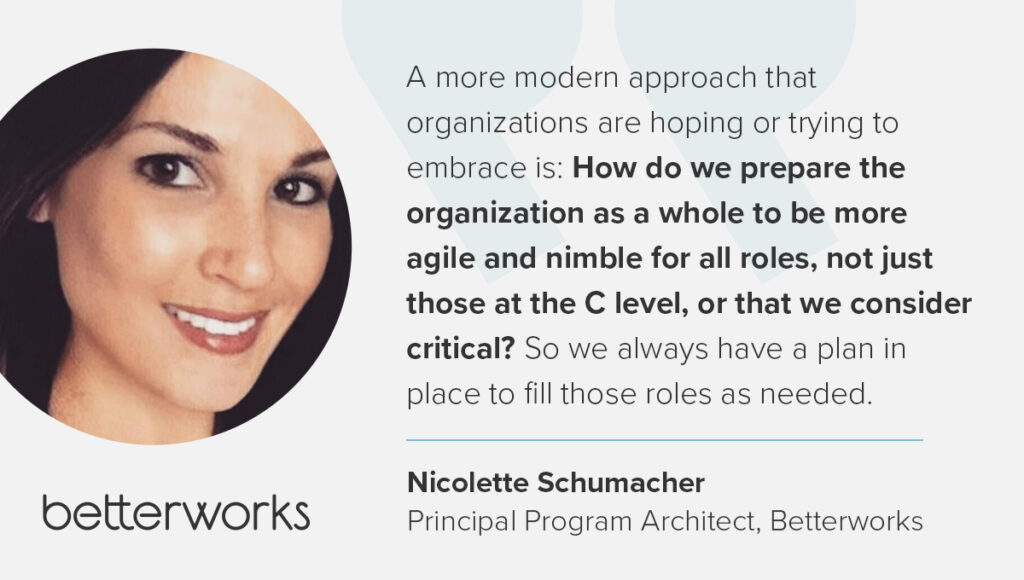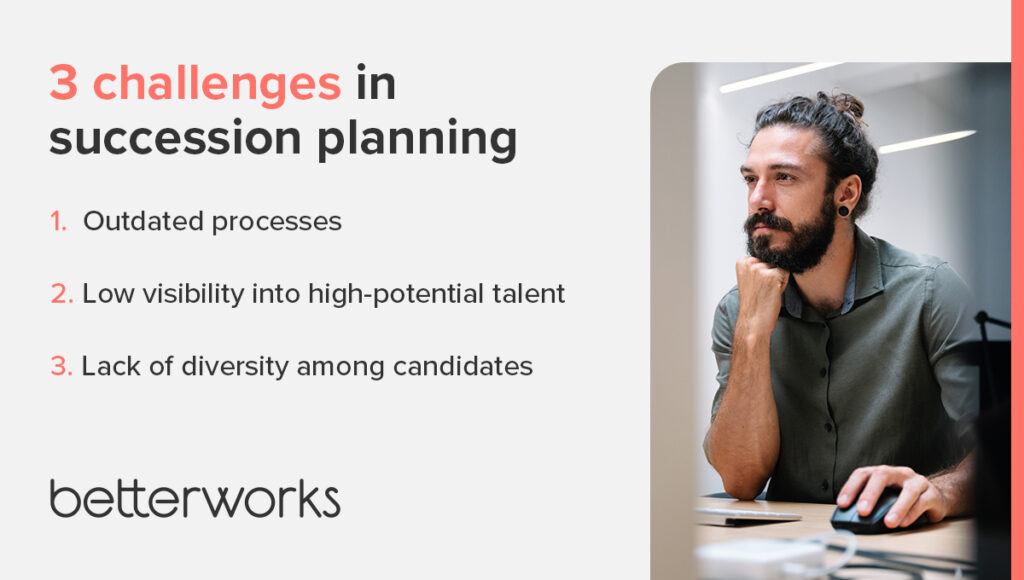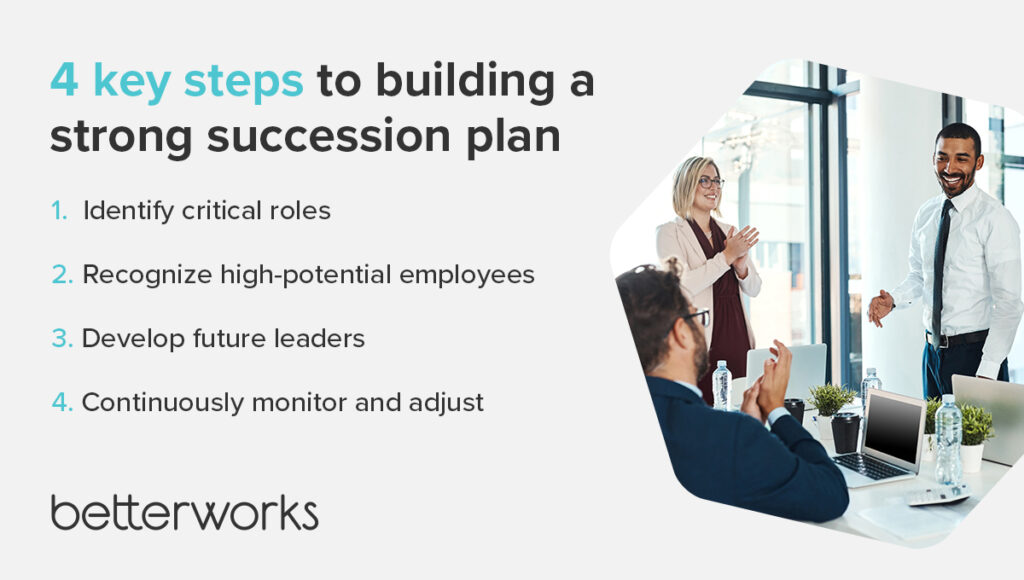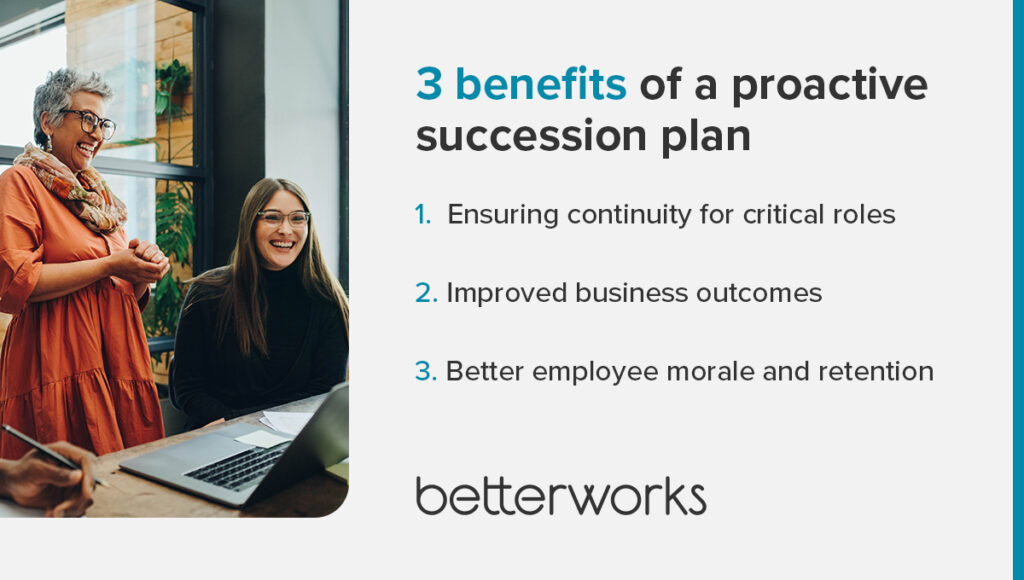Leadership transitions are more than just personnel changes — they’re critical inflection points that can make or break an organization’s future. That’s why developing an effective succession planning strategy deserves a top spot on your list of priorities as an HR leader.
The stakes are high. According to one analysis published in the Harvard Business Review, the market value lost due to poorly managed CEO and C-suite transitions in the S&P 1500 is staggering, amounting to nearly $1 trillion annually. This isn’t just an issue of leadership gaps or temporary disruptions: It’s a financial drain on companies and their shareholders.
But here’s the silver lining: Better succession planning could significantly alter this narrative.
Find out what goes into an effective succession planning strategy, and how better succession planning can foster stability in the face of change.
What is succession planning and why does it matter?
Succession planning is a strategic approach to identifying and developing future leaders within your organization, whether they be in executive positions or mission-critical roles. By systematically planning for future leadership transitions, companies can minimize disruption, reduce costs, and ensure their business remains competitive.
Traditionally, succession planning has focused on identifying top talent for senior leadership roles. But modern organizations are moving towards a more holistic and effective leadership succession planning approach, preparing for transitions at all levels of the organization. “I think it’s merged a bit now, where we’re at today,” says Betterworks Principal Program Architect Nicolette Schumacher. “A more modern approach that organizations are hoping or trying to embrace is: How do we prepare the organization as a whole to be more agile and nimble for all roles, not just those at the C level, or that we consider critical? So we always have a plan in place to fill those roles as needed.”
This more thoughtful corporate succession planning framework focuses on nurturing high-potential employees (HiPos) across departments to create an agile and adaptable workforce. By doing so, you can drive both leadership continuity and organizational stability.

3 challenges in succession planning
While succession planning is critical for long-term success, it comes with its own set of challenges. From identifying future leaders to ensuring diversity, talent management and succession planning can be complex and time-consuming without the right tools and strategies.
Without careful attention, these challenges can hinder leadership development and leave organizations unprepared for transitions.
Outdated processes
Many companies still rely on manual processes, such as spreadsheets, to manage succession planning. These outdated tools lead to inefficiencies and errors, making it difficult for organizations to remain agile. There’s a growing need for organizations to adopt technology that allows them to centralize their succession planning process, Nicolette says. Using a system that pulls together people data from across the organization can reduce manual workload and inefficiencies, improve data accuracy, help you make better decisions about who to promote and how to help them develop, and help you keep the plan on track with business goals.
Low visibility into high-potential talent
Without a structured process for identifying potential leaders and developing internal talent, it’s easy to overlook key team members who could excel in leadership roles. “Often, you have the same people in the organization owning the process of succession, so they’re really, really close to it,” Nicolette says. “They sort of lose sight of what exactly they’re looking for — and they miss out on a lot of the key things that could be being developed further.”
That’s why data is an indispensable part of your succession planning strategy. The right data surfaces hidden and verifiable skills through talent profiles, enabling your HR team to make informed decisions about future leaders. Data-driven succession planning ensures that potential leaders aren’t missed due to decentralized or informal processes.
Lack of diversity among candidates
One of the major challenges to good succession planning is a lack of diversity in the candidate pool. Leaders often rely on informal networks to populate leadership pipelines — but that often perpetuates bias, since humans gravitate towards people similar to themselves.
This can result in promoting candidates who are similar to current decision-makers, rather than casting a wider net to include diverse candidates who bring fresh perspectives. A succession planning framework that incorporates diversity metrics can improve business outcomes by fostering innovative, inclusive leadership teams.

Consequences of not creating a succession plan
Failing to create a robust succession plan can have serious consequences that ripple across an organization. Without a clear roadmap for leadership transitions, companies face disruptions in operations, increased turnover, and potential financial losses. In the absence of proactive planning, leadership gaps can weaken organizational stability and hurt long-term growth.
Leadership and talent gaps
One such business risk is the potential to experience leadership gaps and turn to external hires to fill them, which often leads to higher recruitment costs. Without internal talent development, organizations may scramble to fill critical roles, which can seriously risk critical operations.
Without a healthy succession plan, organizations may experience leadership gaps that create instability and weaken the company’s direction. A well-known case of poor leadership transition occurred at Disney. When Bob Iger handed the CEO role to Bob Chapek in 2020, it seemed like a smooth transition. However, weeks into Chapek’s tenure, the Covid-19 pandemic struck, forcing Disney to close its theme parks.
As the crisis unfolded, Iger, who had moved to the role of executive chairman, publicly stated that he would need to step back into a more hands-on role to assist Chapek. This power shift angered Chapek and triggered a tense power struggle between the two leaders. A series of missteps by Chapek further undermined his leadership.
These blunders, combined with financial losses, culminated in Disney’s board parting ways with Chapek after only 22 months and reinstating Iger as CEO. This example illustrates how an ineffective succession plan can lead to leadership turmoil and reputational damage for a business.
Resentment from employees
Lack of professional development opportunities and visibility into future career growth can breed resentment and disengagement among employees, especially those identified as high-potential employees (HiPos). When individuals see no clear path to advancement, they may feel undervalued or stagnant in their roles, leading to decreased motivation, lower productivity, and ultimately, disengagement.
High-potential employees, in particular, are often driven by growth opportunities and challenges. When they are not recognized or supported through mentorship, leadership development, or clear career pathing, they may feel that their talents are being underutilized. This sense of being overlooked can cause them to seek opportunities elsewhere, creating talent gaps within the organization and forcing the company to invest more resources in external hiring and training new talent.
Increased costs to the business
Without a proactive approach to career pathing and leadership development, organizations face increased costs due to frequent turnover, missed growth opportunities, and reduced business operations.
Moreover, Nicolette explains, external recruiting to fill senior leadership roles often becomes more competitive and costly than developing that talent in-house — and produces less effective results, a conclusion supported by the Harvard Business Review analysis. Proactively nurturing internal talent can help avoid these financial and operational costs.
4 key steps to building a strong succession plan
To create a succession planning framework that drives long-term success, HR leaders must focus on key steps that integrate data-driven talent management and leadership development strategies.
Identify critical roles
Begin by identifying which roles are critical to your organization’s success and need a succession plan. This includes not just executive-level roles but any positions that are essential to maintaining business continuity, Nicolette says.
Recognize high-potential employees
Invest in aligning managers and leaders on what top talent looks like. “Practice that skill set and build that muscle within the organization,” Nicolette says. “What does it mean to always be identifying what top talent is, and how do we measure it?”
Use talent profiles and succession planning software to identify high-potential employees who have the skills and aptitude to take on leadership roles in the future. Nicolette emphasizes the importance of not relying solely on current job titles or performance metrics. Instead, consider soft skills, adaptability, and employee aspirations when building a pool of future leaders.
Develop future leaders
Once you’ve identified high-potential individuals, invest in their training and development. Create a comprehensive learning and development program that includes leadership coaching, mentorship, and real-world experiences that prepare employees for future leadership roles. These could include job rotations, for example, that provide a breadth of experience that is important for exposure and advancing skill sets. Nicolette highlights the need for organizations to provide structured pathways for professional development to keep employees engaged and your leadership pipeline full.
In addition to focusing on how to advance employees into key roles, it is also essential to consider who will fill vacated roles when employees are promoted. Ensuring you have a pipeline of employees ready to rise up in the organization is part of having a comprehensive succession planning program.
Continuously monitor and adjust
Succession planning is not a static process. Continuously monitor your talent pools, leadership development initiatives, and business needs, adjusting the succession plan as necessary to remain aligned with business operations.

3 benefits of a proactive succession plan
The benefits of succession planning go far beyond simply filling leadership roles. A well-executed plan ensures smooth transitions, promotes employee development, and strengthens overall business resilience. By proactively preparing for the future, organizations can boost morale, improve retention, and foster long-term success.
Ensuring continuity for critical roles
A well-executed succession planning strategy ensures that your organization remains agile and ready for leadership transitions at any level, from department heads to senior leaders and critical roles. A robust succession planning process leads to greater organizational stability and the ability to adapt quickly as needs change.
Improved business outcomes
Organizations that prioritize diversity in their succession plans achieve better business outcomes. Diverse leadership brings fresh perspectives, innovative solutions, and a deeper understanding of customer needs. This diversity is key to maintaining a competitive edge in today’s market.
Better employee morale and retention
By offering clear career pathing and growth opportunities even for those not moving into management roles, succession planning also boosts overall employee morale and retention. Employees who see a future within the company are more likely to stay engaged and committed to their roles. As Nicolette notes, professional development and leadership development are key motivators for retaining top talent.

Future-proof your organization with succession planning
To secure your organization’s long-term success, succession planning must be an ongoing, strategic initiative that integrates data-driven insights, talent management, and leadership development. By preparing for the future now, you can ensure that your company remains resilient, innovative, and well-positioned for growth.
Keep in mind that a proactive succession plan doesn’t just benefit the organization — it benefits your employees, too. By focusing on high-potential employees, providing professional development, and fostering an inclusive approach to leadership, you can create a thriving, future-proof organization.
Want to learn more about how to prepare tomorrow’s leaders today with the right skills? Read our State of Skill Fitness in 2024 report.
Develop your talent pipeline








